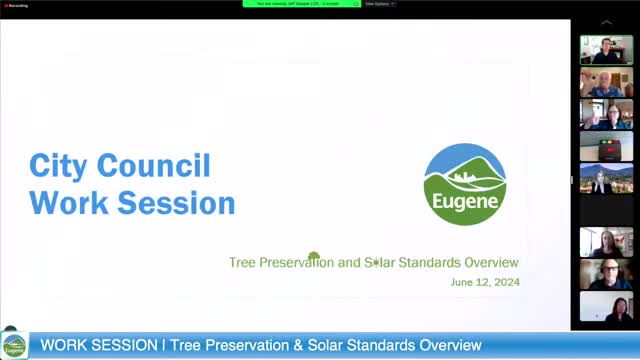City plans bold tree preservation strategy amid housing growth
June 12, 2024 | Eugene , Lane County, Oregon

This article was created by AI summarizing key points discussed. AI makes mistakes, so for full details and context, please refer to the video of the full meeting. Please report any errors so we can fix them. Report an error »

In a recent government meeting, city officials discussed critical updates regarding tree preservation standards and solar setback regulations, emphasizing their importance in the context of urban development and housing. Senior Planner Jeff Kepper presented the tree preservation standards, which aim to maintain a healthy urban canopy while accommodating the city's growth and housing needs.
Kepper highlighted the dual focus of the tree preservation standards on public and private trees, noting that public trees include those in parks and along streets, while private trees pertain to those on individual properties. The discussion underscored the necessity of balancing urban density with the preservation of significant trees, defined as those with a diameter of eight inches or more.
The tree preservation framework is governed by two main chapters of the land use code: Chapter 9, which pertains to land use applications and development permits, and Chapter 6, which addresses tree removal regulations. The latter imposes strict guidelines, allowing tree removal only under specific circumstances, such as for dead or hazardous trees, or with a permit for significant removals.
Kepper also connected the tree preservation standards to the ongoing conversation about middle housing, which was a focal point during the city's housing policy discussions in 2022. He emphasized that the standards apply equally to various housing types, including single-family homes and accessory dwelling units (ADUs), ensuring that tree preservation remains a priority regardless of the development scale.
The meeting concluded with a recognition of additional regulations that support urban canopy preservation, including landscaping standards for commercial developments and strict protections for riparian and wetland areas. These measures collectively aim to foster a sustainable urban environment while accommodating the city's growth objectives.
Kepper highlighted the dual focus of the tree preservation standards on public and private trees, noting that public trees include those in parks and along streets, while private trees pertain to those on individual properties. The discussion underscored the necessity of balancing urban density with the preservation of significant trees, defined as those with a diameter of eight inches or more.
The tree preservation framework is governed by two main chapters of the land use code: Chapter 9, which pertains to land use applications and development permits, and Chapter 6, which addresses tree removal regulations. The latter imposes strict guidelines, allowing tree removal only under specific circumstances, such as for dead or hazardous trees, or with a permit for significant removals.
Kepper also connected the tree preservation standards to the ongoing conversation about middle housing, which was a focal point during the city's housing policy discussions in 2022. He emphasized that the standards apply equally to various housing types, including single-family homes and accessory dwelling units (ADUs), ensuring that tree preservation remains a priority regardless of the development scale.
The meeting concluded with a recognition of additional regulations that support urban canopy preservation, including landscaping standards for commercial developments and strict protections for riparian and wetland areas. These measures collectively aim to foster a sustainable urban environment while accommodating the city's growth objectives.
View full meeting
This article is based on a recent meeting—watch the full video and explore the complete transcript for deeper insights into the discussion.
View full meeting
